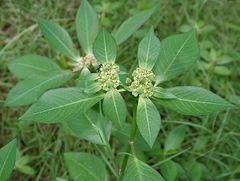ورديات (صُفيف)
| ورديات | |
|---|---|

| |
| Euphorbia heterophylla | |
| التصنيف العلمي | |
| مملكة: | |
| (unranked): | |
| Class: | |
| (unranked): | صفيف الورديات Rosids
|
| الرتب | |
|
طالع النص | |
صُفيف الورديات rosids هي مجموعة هائلة من النباتات المزهرة، تضم نحو 70,000 نوع،[1] أي ما يزيد على ربع جميع كاسيات البذور.[2] وتنقسم إلى 16 إلى 20 رتبة، حسب circumscription والتصنيف. هذه الرتب، بدورها، تنقسم إلى نحو 140 عائلة.[3] صـُفيفا الورديات rosids والنجميات asterids هما، بفارق كبير، أكبر المجموعات في ثنائيات الفلقة الحقيقية eudicots.
النسل
The phylogeny shown below is adapted from Wang and co-authors (2009),[1] with order names from the Angiosperm Phylogeny Website.[4] Branches with less than 50% bootstrap support are collapsed. Other branches have 100% bootstrap support except where shown.
| eurosids |
| ||||||||||||||||||||||||||||||||||||||||||||||||||||||||||||||||||||||||||||||||||||||||||
السلالة المثبـِّتة للنيتروجين nitrogen-fixing clade تضم عدداً كبيراً من النباتات عقدية الجذور actinorhizal plant (التي لها عقد جذرية root nodules تحتوي على جراثيم مثبتة للنيتروجين، مما يساعد النبات على النمو في الترب الفقيرة). إلا أن ليست كل النباتات في هذه السلالة هي عقدية الجذور.
الهامش
| ورديات (صُفيف)
]].- ^ أ ب Hengchang Wang, Michael J. Moore, Pamela S. Soltis, Charles D. Bell, Samuel F. Brockington, Roolse Alexandre, Charles C. Davis, Maribeth Latvis, Steven R. Manchester, and Douglas E. Soltis (10Mar2009), "Rosid radiation and the rapid rise of angiosperm-dominated forests", Proceedings of the National Academy of Sciences 106 (10): 3853–3858, doi:, PMID 19223592, http://www.pnas.org/content/106/10/3853.abstract?etoc
- ^ Robert W. Scotland and Alexandra H. Wortley (2003), "How many species of seed plants are there?", Taxon 52 (1): 101–104, doi:
- ^ Douglas E. Soltis, Pamela S. Soltis, Peter K. Endress, and Mark W. Chase (2005), Phylogeny and Evolution of the Angiosperms, Sunderland, MA, USA: Sinauer, ISBN 978-0878938179
- ^ خطأ استشهاد: وسم
<ref>غير صحيح؛ لا نص تم توفيره للمراجع المسماةapweb